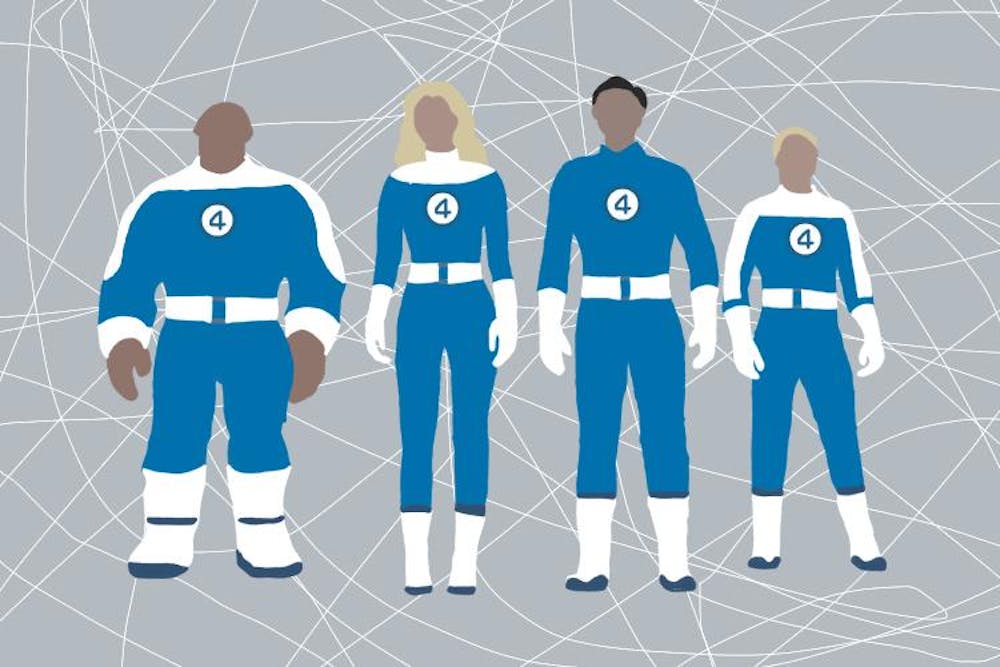The cinematic history of Marvel’s “Fantastic Four” — a beloved comic-book superhero team since 1961 — can be described as anything but “fantastic”. 1994’s “The Fantastic Four,” to start, had its premiere in theaters abruptly canceled, to ultimately never arrive. The franchise was rebooted with 2005’s “Fantastic Four” and its 2007 sequel “Fantastic Four: Rise of the Silver Surfer,” both of which were poorly received. 2015’s “Fantastic Four”, stylized as “FANT4STIC,” re-rebooted the adaptation — only to bring it to new lows. The three films together sum to a critics score of just 74 percent on Rotten Tomatoes.
Facing that rocky legacy, director Matt Shakman took on a new big-screen interpretation of the team with “The Fantastic Four: First Steps,” which debuted in theaters July 25. Fittingly, the fourth adaptation delivered a film that easily eclipses its infamous predecessors. Shakman’s take on the hero family is as new as it is nostalgic with lovable versions of each classic team member on the excitingly immersive Earth-828.
Set in 1960, “First Steps” introduces the superhero family with a brief montage of their extraterrestrial origin story, wherein cosmic rays granted the four former astronauts various life-changing superhuman abilities.
Eminent genius Reed Richards, played by Pedro Pascal, had his intelligence greatly enhanced and was granted the ability to stretch his body into any shape. His wife Sue Storm — played by Vanessa Kirby — could now create forcefields and turn invisible. Joseph Quinn plays her brother Johnny Storm, now able to fly and control fire. Reed’s best friend Ben Grimm, played by Ebon Moss-Bachrach, transformed into a mass of orange rock with enhanced durability and strength.
The main story then unfolds in 1964 between New York and outer space, where Reed leads the Fantastic Four as “Mr. Fantastic.” Sue becomes the “Invisible Woman,” Johnny is the “Human Torch” and Ben is known as “The Thing.”
“First Steps” promptly reveals that Reed and Sue are expecting a child — eventually named Franklin. As the two hurriedly prepare for their newborn, the Silver Surfer, played by Julia Garner, suddenly heralds that Earth-828 is soon to be consumed by her overlord Galactus — a world-eating deity played by Ralph Ineson. When Galactus takes an obsessive interest in Franklin, the fight against him becomes deeply personal.
Perhaps the greatest strength of the film lies in the warm and retrofuturistic sci-fi art direction that weaves familial bonding with imminent disaster and space travel with nostalgic Americana. Production designer Kasra Farahani and Shakman unabashedly revel in 1960s nostalgia and relentless optimism of the Fantastic Four in their blueprints of Earth-828. Cheery, patriotic citizens pack the streets of New York to praise our heroes’ routine victories. Schoolchildren huddle around appliance stores, enchanted by superhero news on stacks of analog tube TVs as flying cars hum above them.
The film finds freedom in being set outside the mainline continuity of the Marvel Cinematic Universe as it embraces its own, sincere visual identity. It is immediately distinguished from its fellow Marvel projects by vintage color grading and consistently wacky stylistic reverence to its 1960s source material. That reverence shines through with playful cinematography, imaginative uses of superpowers and mesmerizing set designs that make our protagonists and their world irresistibly charming altogether.
New York City’s skyline is partly faithful to its real-life 1960s counterpart with additions reminiscent of the midcentury futurist skyscrapers in 1962 cartoon classic “The Jetsons”. The interiors of the Baxter Building — our protagonists’ headquarters, labs and apartments — are airy, rich and round. Overall, the project is undeniably an aesthetic treat, and its characters prove to be almost as sweet.
The film makes a great effort at providing enough separation amongst the team to peer into each member’s unique turmoils, desires and abilities. Reed Richards’ intellect is stretched by the unknown that is parenthood, Sue Storm’s pregnancy woes come at the least convenient hour and Johnny Storm’s fiery one-on-one confrontations with the Silver Surfer give him a special role against Galactus. That effort is condensed into a sub-two hour runtime, however, and Ben Grimm gets the shortest end of the stick. The film’s scattered hints of Grimm’s desperate longing to escape his brutish bouldered form and his half-baked romantic subplot unfortunately do not amount to much.
Our antagonists feel similarly dampened by that trimmed runtime. To compensate for some lack in narrative depth, the Silver Surfer relies on riveting light-speed action sequences and Galactus on his imposing design and brilliantly-communicated scale.
Simply put, the film’s visuals and main ensemble are more interesting than the details of conflict they face. It can feel as though that conflict only exists so those visuals and characters can be paraded prior to their appearance in 2026’s “Avengers: Doomsday” — and particularly so in the repeated hints to Franklin’s latent powers, presumably reserved for future films.
Audiences will leave cinemas excited to see the family in action again but not ruminating over the generally predictable story. Some subplots seem undercooked and viewers may get the sense that a chunk of substantial story beats were axed from the final cut. The presence of those cut scenes can be felt throughout the film as its chronology becomes somewhat muddy.
Still, “First Steps” is a fun and heartfelt introduction to Marvel’s newest family. The inherent intimacy in its familial themes creates a touching experience that makes its star quartet remarkably easy to connect with. With the Fantastic Four’s first few footsteps in the general right direction, Shakman has blazed a path towards an exciting destination in Marvel’s extended universe.







